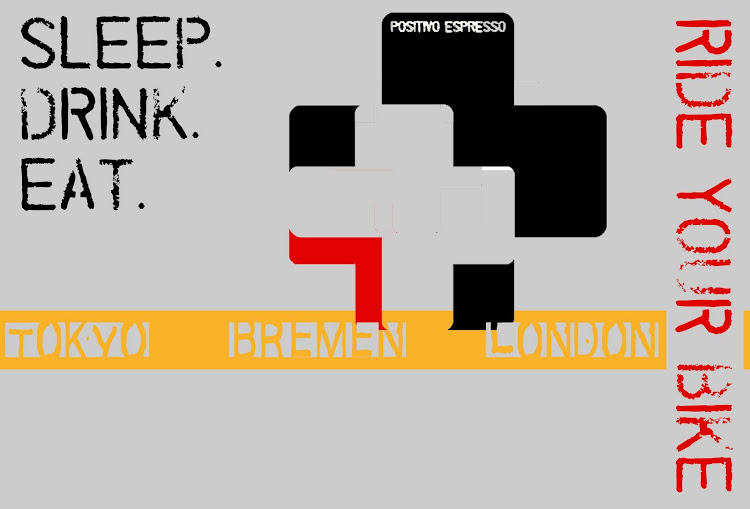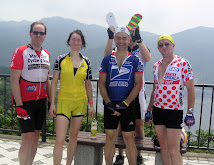Having returned to Tokyo this morning, I can at least use my jet lag induced wakefulness to give a brief report on Acte II of this year's Etape. I will follow up later with the more interesting bits of my trip to France and some good stories of my happy time with the family Bouhet, as well as photos before and after race day ... but not enough time tonight.
Acte II was to follow Stage 9 of the Tour de France, 208km and 3600+ meters of climbing from Issoire to St. Flour via a loop through the mountains of the Massif Centrale and some beautiful countryside. Even though the stage did not include any Galibier or Stelvio, no Mortirolo or Alpe d'Huez, it did include at least six Cat 2 and Cat 3 climbs, the highest being the 1589m elevation Pas de Peyrol, as well as lots of other nasty shorter sections of climbing. So we knew it would be a hard course. One analyst declared it "made to measure for a strong man. ... Except for the first 50 km, it's just climbs and descents all of the way. It’s a real leg-breaker." Cyclingnews quotes another as saying "People associate the Alps and Pyrenees with the brutality of the Tour, but days like this are generally much, much harder. They will be full gas for 150km, and lots of strong guys will be targeting it."
When the pros had ridden it the week before, it had been a scene of some memorable crashes, including one that knocked Dave Zabriskie, Alexandre Vinokourov and several other top contenders out of the 2011 Tour, and another crash where a France TV4 publicity car hit Juan Antonio Flecha and Johnny Hoogerland and sent them flying, Hoogerland directly into a barbed wire fence. One of the younger British riders with my tour operator had told his parents, who never watch cycling, to be sure to watch Stage 9 so they could see where he would be riding the following week. He deeply regretted this as the carnage revealed itself and his parents began to question his sanity. People called it a crazy stage.
Another potential issue was the weather. From Friday onward, the forecast for Sunday had predicted at least some rain. Some of the forecasts were for "heavy rain", while other suggested there would just be showers off and on throughout the day. No one mentioned particular cold.
When I awoke a 4AM I stepped outside briefly -- warm and a bit humid, but still dry. So I planned for rain gear but nothing extraordinary -- my usual summer sweatband and half length gloves, normal jersey, bib shorts and socks, and my goretex shell for any rain and to keep a bit warmer on the descents. I did put on some thin arm warmers, in the thought that I might be cold standing around at the start, but otherwise typical gear for a summer ride with some risk of rain.
The rain started as we were still en route to Issoire and had really picked up by the time I got out of the bus and found start area #6. Fortunately, I was able to wait standing under a shop awning, and to duck into a restaurant for a large hot cafe au lait -- still dry, I felt ready to go, with the prospect of conditions that would maximize my comparative advantages (strength and a little extra meat on the bones, plus training that did involve riding 200km in the rain and cold every once in awhile). I stepped back into the rain just as the gun went off and the front group started, and after 15 minutes of inching forward, we too were off.
Conditions were wet but tolerable for the first 40 km. My rear tire flatted at that point, just at the bottom of the first climb, and I changed it and moved on without incident. Many people were suffering flats and other mechanical issues in the wet -- the small gravel and gunk that gets onto the road in the rain always seems to cause these. Later I heard many complaints of riders whose hands were too cold to change a tire or even to open a presta tire tube valve after they flatted.
After the first categorized climb, I settled into an incredibly long, hard slog, as the route went almost due west on a higher plain with a general uphill tilt, into an accelerating headwind and a real downpour ... over the next 40 km. The wind was brutally strong and cold. Very quickly the pace slowed, groups of 10, 20 or 30 riders making forward progress at 18-20 kph. A rider from my tour operator, who ended up placing #40 overall out of the thousands of participants, told me that on this stretch even the front group was managing only a little better than 20 kph.
I started to see riders heading back down the road toward me, 1 or 2 at a time. After 10 or 20 had passed, I realized what was up -- they had given up and were going downwind/downhill to seek shelter. Then as I passed a village I saw a group of maybe 30 road bikes stacked by the side of the road, no sign of the riders, who were probably in one of the nearby houses. Anyway, I pushed ahead, trying to move forward from group to group, whenever possible doing so together with another rider or two who would share the work. Sure, it was cold and wet, but not as cold, and not nearly as wet, as Kiyosato and Nobeyama in the driving rain at midnight in April.
Anyway, I had one minor incident (another broken spoke -- this time on my front wheel, which remained rideable, barely) and so did two of the descents at significantly reduced speed until, 20 km or so up the road I did manage to get a spare wheel from the Mavic team to use for the last 50+ km, and slogged through to the finish, pulling a few groups on the downhills.
My time was 10 hrs and 5 minutes. I was finisher number 1390, out of around 6000 who registered, 4000 who started, and 1982 who recorded official times -- a significant improvement on Acte I. (The results, searchable by name or Dossard number, can be found here. I was Dossard number 3113). Only four riders managed to break 7 hours. Jerome came through in 10 hrs and 53 minutes. Didier had a major mechanical issue (broken derailleur hanger sends rear derailleur flying into gears) and was forced to abandon after 75 km.
Laurent had the most frustrating day. He was in start area 9 and so further back in the stream of thousands than I. When he entered Allanche, after a significant portion of the downpour/headwind/uphill section, it was "a war zone". He was cold but otherwise okay, and made the mistake of listening to the organizers on-site who were telling people there was fog (true) and snow (false) on the Pas de Peyrol, and advising that they give up and head toward St. Flour by a lower road. The police did apparently close Pas de Peyrol at one point and redirect riders by a different route, but that let them continue the rest of the course. Laurent was really angry with the organizers, and with himself for having listened to them. One expects he will have had plenty of chance to recover his spirit by riding the courses of Liege-Bastogne-Liege and Fleche Wallone this week.
I talked with another strong rider at the Lyon Airport, who had come from Canada to serve as "domestique" for a top competitor. His leader had ended up abandoning with hypothermia on this stretch. Our tour operator's group included about 15 Brazilians. Not used to riding in the cold, only 3 completed the event.
The townspeople were great. They lined the road in every city, town, village and hamlet, and they offered shelter and, apparently, hot liquids, to those who got in real trouble. I was grateful for the constant cheers of "allez, allez, courage", willing us along. This is the real French countryside, a part of France where epic cycling duels have been fought ... but that will need to wait for another post.
As the ASO website site notes, this 2011 second act deserves "a place on the podium" of the most difficult editions of Etape du Tour.
Elevation profile:
Subscribe to:
Post Comments (Atom)












No comments:
Post a Comment